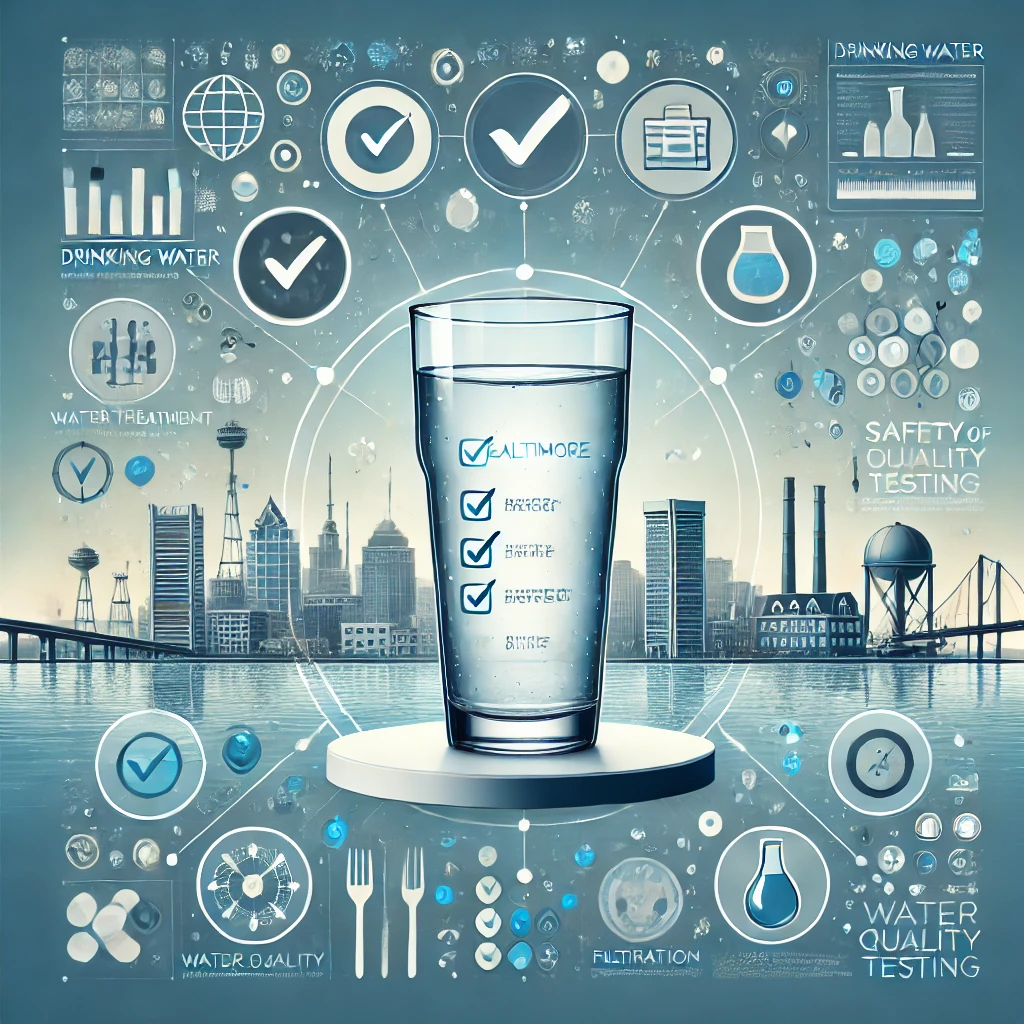
Health and Wellness
Is the Water in Baltimore Safe to Drink? Everything You Need to Know


DINKAR
10/27/2024
Introduction: The safety of drinking water is a vital concern, especially for residents in major cities like Baltimore, where water quality can be impacted by multiple factors, from infrastructure to natural resources. In this article, we’ll explore the current state of Baltimore's drinking water, recent quality reports, common contaminants, and steps you can take to ensure the water you drink is safe. Let’s dive into what you need to know about drinking water safety in Baltimore.
1. Overview of Baltimore’s Water Source
Baltimore sources its drinking water from three main reservoirs: Loch Raven, Prettyboy, and Liberty. These reservoirs supply water to millions of residents across the city and surrounding areas. The water is treated by the Department of Public Works (DPW) before it reaches homes, where multiple treatment processes help ensure contaminants are minimized and the water meets federal and state safety standards.
- Loch Raven Reservoir – Located in Baltimore County, providing a significant amount of the city’s drinking water.
- Prettyboy Reservoir – Situated north of Loch Raven, also an essential source.
- Liberty Reservoir – In Carroll and Baltimore counties, contributing to the overall water supply.
2. How Baltimore’s Water is Treated
The Department of Public Works uses a series of treatment processes to clean the water, including:
- Coagulation and Flocculation: Chemicals are added to bind small particles into larger ones.
- Sedimentation: The larger particles settle at the bottom, allowing clear water to flow to the next stage.
- Filtration: Filters remove remaining impurities.
- Disinfection: Chlorine and other disinfectants kill any remaining bacteria or pathogens.
These processes are essential to remove potential contaminants like dirt, bacteria, and other pollutants. DPW also continuously monitors the water to ensure it meets safety guidelines set by the Environmental Protection Agency (EPA) and other regulatory bodies.
3. Recent Water Quality Reports and Findings
Baltimore's annual water quality report provides critical insights into the city’s water safety. The report assesses various contaminants, including lead, nitrates, chlorine, and microbial contaminants. Here’s a summary of key findings from recent reports:
- Lead: Some Baltimore homes, especially those with older plumbing, may have higher lead levels. The DPW advises residents to flush taps for 15–30 seconds if lead contamination is a concern.
- Chlorine and Byproducts: Chlorine is used in disinfection, but byproducts like trihalomethanes (TTHMs) and haloacetic acids (HAAs) can form, which may cause health risks over time.
- Microbial Contaminants: While microbial contaminants are generally controlled, occasional advisories are issued, especially following severe storms or environmental disruptions.
The most recent data confirms that Baltimore’s water meets EPA standards, but caution is advised for vulnerable populations, including children and pregnant women, particularly regarding lead exposure.
4. Common Contaminants in Baltimore’s Drinking Water
Baltimore’s drinking water is generally safe, but specific contaminants may still be present, including:
- Lead: Lead can leach into water from old pipes, so older homes may have a higher risk. Regular testing and filtering can help reduce exposure.
- Chlorine Byproducts (TTHMs and HAAs): Long-term exposure to TTHMs and HAAs may increase health risks.
- Nitrates and Nitrites: These can enter the water through agricultural runoff and may pose health risks, especially for infants.
- Pathogens: While rare, bacteria like E. coli and cryptosporidium may occasionally be detected following severe weather or system failures.
Each of these contaminants has been monitored by the city, but residents can take additional steps, such as home filtration, to reduce their exposure.
5. Tips to Ensure Your Drinking Water is Safe
Although Baltimore’s water supply is considered safe, you may still want to take extra precautions for peace of mind:
- Use a Water Filter: Choose filters certified to remove lead, chlorine, and other common contaminants. Reverse osmosis systems, activated carbon filters, and water softeners are popular choices.
- Flush Your Pipes: Especially if you live in an older home, running your water for 30 seconds before drinking can help reduce lead exposure.
- Stay Informed: Sign up for water quality alerts and advisories to stay updated on any issues affecting your area.
- Conduct a Home Water Test: You can purchase a water testing kit to check for lead, nitrates, and other contaminants.
6. Baltimore’s Initiatives to Improve Water Quality
The city has committed to updating infrastructure to improve water safety and reliability. Recent initiatives include:
- Lead Pipe Replacement: Baltimore has programs for identifying and replacing older lead pipes, which have been a primary concern for water safety.
- Enhanced Treatment Facilities: Investments in state-of-the-art treatment facilities help reduce contaminants more effectively.
- Public Awareness Campaigns: The DPW has initiated campaigns to educate residents about safe water practices and ways to reduce exposure to contaminants.
7. Frequently Asked Questions (FAQs)
- Is it safe to drink tap water in Baltimore? Baltimore’s tap water is generally safe and meets federal standards, though certain groups may want to take extra precautions.
- What should I do if I’m concerned about lead in my water? Consider using a water filter certified for lead removal and flush your pipes before drinking.
- How often should I test my home’s water? It’s generally recommended to test annually, especially if you live in an older home or have young children.
- What should I do during a boil water advisory? During advisories, boil water for at least one minute to kill any pathogens before consuming it.
Conclusion
In summary, Baltimore’s water is regularly tested and treated to meet federal standards, and while it’s generally safe to drink, some households—particularly those in older homes—may benefit from additional precautions. Using a certified water filter, flushing pipes, and staying informed through local water quality reports are all ways to ensure the water you drink is as safe as possible.
By being proactive and staying aware of water quality measures, Baltimore residents can confidently manage their water safety for their health and well-being.